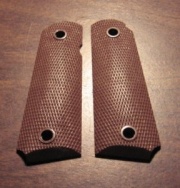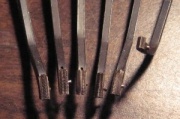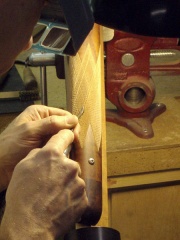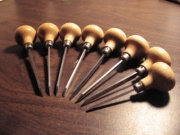Gunsmith
A gunsmith is a person who repairs, modifies, designs, or builds firearms to factory or customer specifications, using hand tools and machine shop tools (such as lathes, milling machines, and grinders).
Gunsmiths may be employed in:
- factories by firearms manufacturers,
- armories by military or law-enforcement agencies,
- sporting goods stores, or
- small gunsmith shops, as either the owner, or as one of a handful of employees.
To pursue the entirety of this trade, a gunsmith must possess skills as a mechanic, a metalworker, a woodworker, and an artisan; be knowledgeable in shop mathematics, ballistics, and chemistry; and be capable of working accurately and precisely. Those who are (self-)employed in small gunsmith shops must also possess skills as small business operators; work effectively with a wide variety of customers; and remain abreast of, and comply with federal, state, and local laws, ordinances, and requirements.
Due to the great breadth of subject matter to be mastered, many gunsmiths specialize in only a few of the skills required of the general gunsmith (see Specializations section below). Alternatively, some gunsmiths learn many of the skills of the trade, but only apply them to a few weapon types (only pistols, or only shotguns, or only (pre-1964) Model '94 Winchester Lever-Action Rifles; for instance).
Contents |
Legal Requirements
Global Overview
In many countries of the world, the possession and ownership of firearms by civilians is highly restricted or, worse, outright illegal (see Gun laws). The practice of gunsmithing is therefore typically restricted. The only firearms-related repairs are by individuals trained and employed by the military or police. These individuals are known as Armorers. Typically, their skill level is usually far below that of the artisan Gunsmith. Where the Gunsmith frequently has to design, manufacture and fit parts ranging from small internal parts and assemblies, the Armorer usually only has to replace standard interchangable parts belonging to only one type, series, or family of military-related firearms. They typically are furnished a large inventory of standard parts that are known to wear and cause malfunctions in the "weapons" they will encounter, and they are simply trained to replace these items until satisfactory function is restored. They are usually employees of military and law-enforcement institutions, and may be officers of these agencies that do these repair ar part of their offical duties. Their repairs are usually only on the weapons and weapon systems that are the offical property of these institutions, and limited to restoring these government-owned firearms to officially sanctioned standards of functionality and configuration.[1]
Nearly all countries of the world allow some civilian ownership of firearms. Even some of the most restrictive, as in the case of Japan and England, have systems in place that, after stringent and expensive licensing procedures are complied with, allow individuals to have ownership of some sort of functioning firearm. The type of arms allowed may be restricted to long guns with single-shot or two-shot capacity, and these might not be allowed to be kept in the residence of the individual, but sporting use of firearms in some way, albeit highly restricted and limited in some regions, is nevertheless almost universal.
In the regions where ownership is permitted but very limited and highly restricted to those individuals able to afford the high costs of acquiring and owning a firearm despite the expense, those firearms that are allowed tend to be fewer in number, but with levels of craftsmanship and decoration that approach that of an art object instead of simply a device to expel a projectile. Gunsmithing in these regions (as in Germany and England) tends to be concerned with the hand crafting of completely custom-made firearms, tailored to the requirements of the owner, and the expense of this type firearm can exceed that of a typical residential dwelling. Germany has a tradition of hunting, but this is generally a very expensive undertaking that limits it's participation to the "well-heeled and Noble". Firearms posession is highly regulated by the Police, and most hunters have only one long gun, and perhaps one pistol. This has led to the development of the "Drilling" a multi-barrel gun that may incorporate a double-barrelled shotgun above with a high-powered single-shot barrel below. These typically have highly sophisticate breech mechanisms, precise fitting, and are hand-engraved by artists specializing in this work. The stocks are usually fitted to the individual and are very expensive wood with highly-figured grain. England makes some of the most expensive hand-crafted firearms in the world, despite a highly restrictive ownership environment. But, as the Gunsmith's patrons are usually well able to afford the high ownership fees and stringent storage requirements, the price of the arm is only secondary. Decoration of these arms, typically double-barreled shotguns, is on par with the plates used to mint currency and is priced about the same. Several of the other European countries follow this pattern, as in Italy, where the art of the Gunsmith has also reached a high level of sophistication. These craftsmen may specialize as in the case of the Gun Engraver and Stockmaker. Generally, these craftsmen-artists serve long apprenticeships under Master Gunmakers. They may also be members of Guilds which sets up apprentice programs (often sponsored by the Governments in these countries as highly-crafted firearms are important items in the export trade), supervise training, and conduct exams where the Journeyman-level Gunsmiths submit sample firearms of their own work in order to be admitted th Guild membership. Many of these artists can only be regarded as "Gunmakers" instead of Gunsmiths, and do repairs only on the very highest grade firearms. Many are able to make substantial livelihood. Many women also participate in these firms, with some of the most exquisite engraving decoration originating as their work.
United States of America
Arguably the majority of the world's firearms in civilian hands are located in the United States of America. By the law of Supply and Demand, the bulk of business for practicing gunsmiths is also in the United States, where, due to the nature of the Second Amendment of the United States Constitution, firearms ownership is not a privilege subject to the whims of the local Governments and Military, but a right guaranteed all law-abiding citizens. Likewise, hunting and sport shooting is not a privilege restricted to the "Wealthy and Privileged", but is a sport enjoyed by millions of law-abiding citizens. The trade of gunsmithing in the United States therefore, runs the gamut of those "Smiths" that do this as a part-time job or hobby, to those whose level of craftsmanship and skill rival that of their European and Continental cousins. Indeed, some US Gunsmiths were either trained in the European Guild/Apprentice system or have studied in the US under Master gunmakers who were. It may range from the back room of a gun shop or sporting goods store, to firms that cater to individuals to whom money is no barrier to their wishes.
The first and highest responsibility of all legitimate Gunsmiths is to ensure their occupation, no matter if it is conducted from that individual's home as a part-time endeavor, or as a proprietor or employee of a top-line gunmaking or customizing establishment, is conducted in strict accordance with the laws covering their occupation. In the United States of America, the Bureau of Alcohol, Tobacco, and Firearms[2] is the primary federal agency overseeing all legitimate businesses that deal with firearms. The BATF is in charge of the licensing of all legitimate firearms dealers and Gunsmiths in the US that regularly engage in business with the public. The issuance of a Federal Firearms License (FFL) involves a thorough background investigation and an inspection of the Gunsmith's premises by an Agent of the BATF. The fee for a FFL is currently $200.00 (for 3 years). The BATF requires all gunsmiths to record all repairs, noting the serial numbers, type of firearm, caliber or gauge, and full particulars of the owner, with an accepted form of Identification to be presented and recorded in the records. Gunsmiths are required to maintain these records in a permanent, non-alterable form. The BATF inspects the premises of all licensed gunsmiths, with unannounced visits at periodic intervals. The BATF is granted the power by the US Government to initiate the prosecution in US Federal Court of gunsmiths that willfully omit or violate these provisions. Punishment can range from losing their FFL (and therefore the privlege to engage in any firearms-related business), to fines and in severe cases, such as conspiring to supply the criminal element with black market weaponry, imprisonment in a Federal prison. Many Gunsmiths also sell firearms, and all sales require extensive recording of the transaction (again in permanent form) and a background check of all prospective purchasers. This is performed through submittal of the prospective purchaser's name and identification particulars to the National Instant Criminal Background Check System (NICS), a computerized system, with human operators dealing directly with the inquiring Dealer/Gunsmith. The sale MUST be fully approved for it to take place. The NICS system is operated by the US Federal Bureau of Investigation[3].
Another responsibility the Gunsmith must bear in mind is compliance with local and regional laws regulating sales (if they also sell firearms) and the types of firearms regulated in their area. Generally, they cannot undertake the repair of a firearm they believe is illegally held by a person not permitted to own a firearm (a convicted felon, for instance) or one that otherwise violates the laws of the jurisdiction in which the owner resides. Although the Second Amendment of the US Constitution was recently reaffirmed by the United States Supreme Court to mean the ownership of a firearm by a law-abiding and qualified citizen of the United States is a fundamental right guaranteed under US law, the ownership of firearms in the US is still governed by a sometimes-baffling array of local laws. These individual laws and regulations vary greatly from state to state, county to county, city to city, and potentially across all jurisdictional lines. Note too, that these laws may change frequently, particularly as new administrations take office, as court cases are decided, and as existing legislation is enacted.
These laws may also vary by:
- firearm type (handgun[? longarm? rifle? shotgun?)
- firearm model (semi-automatic? full automatic? caliber?)
- intended modification (minimum barrel length? magazine size? fully-automatic?)
- customer or recipient (legal owner? felon? background check?)
- quantity of firearms (how many per week? per month?)
etc.
It is the gunsmith's responsibility to ensure that all requirements pertaining to the practice of this trade are complied with. Seek competent legal advice!
Responsibilities
The primary technical responsibility of gunsmiths is to ensure that the weapons they work on function safely.
They accomplish this firstly by always properly observing gun safety handling procedures: both in their own actions, and in the actions of their customers and the people around them.
They accomplish this secondly by inspecting firearms to ensure safe mechanical operation. Gunsmiths use their in-depth knowledge of firearms to guide these inspections: either repairing deficiencies or notifying customers of unsafe conditions and taking steps to prevent catastrophic failures.
Only some of the ways that even properly handled firearms can fail and endanger their users and those around them are:
- Improper Assembly (see: Ross rifle)
- Missing Parts
- Cracks: all cracked parts are cause for concern, but especially so in the chamber-area, bolt, bolt-lugs, or buttstock.
- Bore Obstructions: being either dented or bent barrels, or foreign material in barrels.
- Improper Headspace: dimensions concerning the relative locations of the chamber and the bolt are not within specified tolerances.
- Improper Timing: (applies to fully automatic firearms).
- Safety-Mechanism Malfunctions: potentially allowing a firearm supposedly on its SAFE setting to unexpectedly fire.
- Worn Sear Edges: potentially allowing a firearm not on SAFE to unexpectedly fire.
- Firing-Pin Tips Deformed: leading to the possibility of primer-rupture.
This list is not comprehensive! Many failure modes are dependent on the particular model of firearm.
Common Tasks
(listed in approximate, but not exact, order of increasing difficulty)
- Keep records of all customers, firearms, and transactions to satisfy ATF requirements.
- Disassemble, clean, inspect, lubricate & reassemble.
- Remove corrosion and touch-up finish.
- Repair burred or damaged parts with files & stones.
- Replace defective parts with factory-made replacements, hand-fitting as necessary.
- Add after-market customizations:
- sling-swivels
- recoil-pads
- iron-sights
- telescopes
- grip caps
- butt plates
- Repair and re-finish wooden stock parts.
- Checker or re-checker grip areas.
- Deepen or clean up worn or damaged engravings & markings.
- Re-crown damaged muzzles on a lathe.
- Repair dented shotgun barrels.
- Install (solder) or repair rib on shotgun barrels, or repair double-barrel assemblies.
- Measure & correct headspace dimensions.
- Check for excessive bore erosion.
- Troubleshoot and repair feeding, ejecting & firing problems.
- Test-fire firearms with conventional loads to ensure proper operation.
- Fabricate wooden stocks to customer specifications and body dimensions. Fit same to existing receiver and barrel.
- Glass-bed actions to stocks to improve accuracy.
- Remove existing metal finish, and re-blue metal parts.
- Fabricate replacement parts from metal stock.
- Modify trigger-pull weight through careful stoning of trigger mechanism parts.
- Fire proof-loads through weapons to insure sufficient strength of parts under over-load conditions.
- Replace worn barrels, which have fired so many rounds that they are no longer of the specified caliber (which leads to loss of accuracy).
- Change caliber or cartridge of existing rifle, by changing barrel, and modifying receiver.
- Recut rifling and change caliber of existing barrel.
- Design and build complete rifles by fitting stock barrels to stock receivers; fabricating or purchasing additional parts as needed, and fitting same to rifle. Fitting custom stock to same.
- Design and build a complete rifle starting with several pieces of blank steel and a slab of walnut; using nothing more than a lathe, saws, files, chisels, & rasps.
Specializations
While some gunsmiths are general practitioners in this trade, some of the more important specializations are:
Custom Builder/Designer
Builds guns to customer's specification, from raw materials and shelf parts. Called upon by professional target-shooters to create highly accurate custom rifles. Likely the most highly skilled of gunsmiths, as they are required not only to have proficiency in the other areas of gunsmithing, but must also be well educated in machining, in order to manufacture the individual components and springs before assembly takes place.
Finisher
Applies various chemical processes (bluing or [Parkerizing]], among others) to the metal parts of guns to develop corrosion resistant surface layers on the steel. Cyanide case coloring is a combined chemical and heat-treatment process which develops mottled tempering colors on steel surfaces: greatly valued for their appearance. Typically, its use is usually restricted to receivers, rarely to barrels. Although providing corrosion resistance, the colored surface layers are subject to wear: antique firearms for sale frequently state what specific percentage of the factory original case coloring remains.
Stockmaker
Carves gun stocks from wood (usually walnut; although birch, maple, and apple wood, among others, are frequently seen). Fits stocks to the metal parts of the gun (receiver and barrel), as well as to customer's body dimensions. The form of stocks are executed using saws, chisels, gouges, rasps, and files. The surfaces are then finished by sanding, scraping, staining, oiling, or lacquering.
Checkerer
(This specialization is frequently combined with that of the Stockmaker) Uses checkering tools to create an ornate pattern of small raised diamonds in the wood surfaces which are to be gripped. The checkering tools are in effect tiny saws, designed to leave a v-shaped groove (of approximately 60 to 90 degrees) in the surface of the wooden gunstock. Special checkering tools consisting of two saw blades in parallel are used to set the spacing (between 16 to 24 lines per inch). The area to be checkered is covered by one set of such grooves parallel to each other. A second set of parallel grooves is then executed across the first set, at approximately a 30 degree angle, leaving the area covered with small pointed diamonds. The edges of the checkered area are frequently ornamented with simple bas-relief wood carving, frequently variations on the fleur-de-lis.Gun Engraver
Uses hand-gravers or die-sinker's chisels to cut designs or pictures into the metal surfaces of the gun, primarily the receiver. Pneumatically driven engraving systems, such as the Gravermeister, developed by GRS, may be used to replace or supplement hand-powered engraving. Other metals (especially gold and silver) may be inlaid and engraved to further the design. Designs usually consist of elaborate scroll-work based upon Acanthus leaves or vines, or may be of purely abstract spirals. The pictures are usually of game animals or birds, and hunting dogs. Before the development of corrosion resistant surface treatments for steel, gun surfaces were engraved to retain more oil to prevent rust. In modern usage, guns are engraved purely for artistic reasons. Top grade engraving may add significantly to the value of quality firearms.Pistolsmith
Specializes in work on pistols and revolvers. Pistolsmiths should be proficient in a range of skills such as woodworking, checkering, machining, metal finishing and metalworking. They must have an excellent understanding of the mechanical characteristics and function of the guns they work on. Often a pistolsmith is called on for extensive customization of a handgun. A good pistolsmith can turn a poorly constructed firearm into one that looks and handles much better.
(Niche) Manufacturer
Some gunsmiths used their experience and skills to become small-operation manufacturers, specializing in making only a few types of gun parts, for sale to other gunsmiths and gunmakers. Some of the more important part categories are:
- barrels
- trigger assemblies
- receivers
- locks (as in 'flintlocks')
Training & Education
All gunsmiths develop and expand their skills through years of experience.
Common ways to get started in Gunsmithing include:
attend Murray State college, Co school of trades, Trinidad State College
- Community Colleges and Correspondence Courses: offer various courses of study (less than two years long) leading to a degree or a certification[4].
- Military Training:
- The U.S. Army trains and employs MOS 45B Small Arms Repairmen [5].The U.S. Air Force trains and employs Combat Arms Instructors (Firearms instructors and small arms repairers)AFSC(MOS) 3P0X1B. The U.S. Marine Corps trains and employs MOS 2111 and 2112 [6].
- The Canadian Armed Forces has the Weapons Technician - Land training, which covers the maintenance and repair of a wide array of weapons, weapons systems and ancillary equipment. Contact a local recruiter for more information [7].
- Apprenticeships: learn directly from active gunsmiths. Talk with gunsmiths in your area, and offer your help around the shop in exchange for learning about this trade.
- The National Rifle Association offers short courses in many common tasks and skills of professional gunsmithing. Contact the NRA for details [8].
Basic machinist skills, while not limited to gunsmithing, are of great help to aspiring gunsmiths. Typical ways to learn machinist skills are:
- High School Shop class.
- Vocational Education.
- Community College courses.
- Apprenticeship programs.
The above information may get one started, but experience at the bench and with individual firearm models is irreplaceable. There is a great deal of information available in print, so self-study and development of new skills is always an option.
Although there is no shortage of paperwork and forms to regulate the activities of practicing gunsmiths in the United States of America, there is no federal certifying or licensing requirement concerning the skill level of someone purporting to be a gunsmith. News of the most highly skilled and talented gunsmiths typically spreads by word of mouth, based on the quality of their work. Beginning gunsmiths' businesses usually start rather slowly, frequently as a second job. It sometimes requires years to develop enough of a customer base to quit your day job and practice gunsmithing full-time. The very best and most talented gunsmiths, however, command premium prices for their services, and may have waiting lists booked for several years in advance.
DIY gunsmithing
Do-it-yourself gunmaking has also been practiced by many people around the world. Especially in certain third-world countries such as Afghanistan, Yemen and other countries in the Middle East, DIY-gunsmithing has become popular. This popularity has been enhanced by certain anarchist books (eg The Anarchist Cookbook, Ragnar Benson's "Guerrilla Gunsmithing: Quick And Dirty Methods For Fixing Firearms In Desperate Times",...), official U.S. Army Field Manuals (which were distributed by the US [9][10][11]), and extremist manuals (eg by Al Qaeda [12], Hezbollah [13], etc.)
References
- ↑ Dunlap, Roy [1950] (R1963). Gunsmithing. Stackpole. ISBN 0-8117-0770-9.
- ↑ Bureau of Alcohol Tobacco and Firearms (BATF / ATF)
- ↑ Federal Bureau of Investigation (FBI)
- ↑ List of Gunsmithing Schools
- ↑ United States Army
- ↑ United States Marine Corps
- ↑ Canadian Armed Forces Recruiting
- ↑ National Rifle Association (NRA)
- ↑ US Army field manuals distributed in the Middle-East by US experts
- ↑ Improvised Munitions Handbook Field Manual benefitting terrorists and translated in Arabic
- ↑ Improvised Munitions Handbook benefitting terrorists
- ↑ Al Qaeda Training manual
- ↑ Hezbollah's manuals describing diy gunsmithing
See also
Bibliography
- Acker, Steve (1989-2000). The Gunsmith Machinist. Traverse City, Michigan: Village Press, Inc.. ISBN 0-941653-63-3. - LOC 00-109501.
- Austyn, Christopher (1998). Gun Engraving. Safari Press. ISBN 1-57157-124-8. - LOC 98-61281.
- Brownell, Frank (1969). Gunsmith Kinks: A Fascinating and Widely Varied Accumulation of Shop Kinks, Short cuts, Techniques and Comments sent by Practicing Gunsmiths from all over the World to F.R."Bob" Brownell. Montezuma, Iowa: F.Brownell & Son, Publishers. - LOC 77-90353.
- Brownell, Frank (1983). Gunsmith Kinks II: A Whole New Collection of Fascinating and Widely Varied Shop Kinks, Cures To Problems, Techniques, Jokes and Comments sent by Practicing Gunsmiths from all over the World to F.R."Bob" Brownell. Montezuma, Iowa: F.Brownell & Son, Publishers. - LOC 77-90353-Vol. II.
- Brownell, Frank (1993). Gunsmith Kinks III: A Wonderful, All-New Collection of Unique Solutions to Gunsmithing Problems, Shop Management Techniques, Jokes and Comments Discovered and Proven By Working Gunsmiths the World Over and Sent to F.R."Bob" Brownell. Montezuma, Iowa: F.Brownell & Son, Publishers.
- Brownell, Frank (2001). Gunsmith Kinks 4: A Fabulous, New Compilation of Tested Cures For Gunsmithing Tasks, Methods For Gun Shop Management, Stories and Jokes Used and Proven By Active Gunsmiths All Over The World and Sent to F.R."Bob" Brownell. Montezuma, Iowa: F.Brownell & Son, Publishers. ISBN 0-9767409-3-1.
- Dunlap, Roy F. (1950,1963). Gunsmithing: A Manual of Firearms Design, Alteration and Remodeling. For Amateur and Professional Gunsmiths and Users of Modern Firearms. Stackpole Books. ISBN 8117-0770-9. - LOC 63-21755.
- Hartliep, Neil (1994). The Basics of Firearms Engraving: a manual of the NRA Gunsmithing Schools Program. Montezuma, Iowa: F. Brownell & Son, Publishers.
- Henderson, David R. (2003). Gunsmithing Shotguns: A Basic Guide to Care and Repair. Guilford Connecticut: Lyons Press. ISBN 1-59228-091-9.
- Lautard, Guy (1986). The Machinist's Bedside Reader: Projects, hints, tips and anecdotes of the trade. West Vancouver, British Columbia, Canada: Guy Lautard. ISBN 0-9690980-2-2.
- Lautard, Guy (1988). The Machinist's Second Bedside Reader (and The Bullseye Mixture). West Vancouver, British Columbia, Canada: Guy Lautard. ISBN 0-9690980-3-0.
- Lautard, Guy (1993). The Machinist's Third Bedside Reader: More Projects, new ideas, and shop know-how. West Vancouver, British Columbia, Canada: Guy Lautard. ISBN 0-9690980-9-X.
- Meek, James B. (1973). The Art of Engraving. Montezuma, Iowa: F. Brownell & Son, Publishers, Inc.. LOC 73-84371.
- Newell, A.Donald (1949). Gunstock Finishing & Care: A Textbook, covering the various Means and Methods by which modern Protective and Decorative Coatings may be applied in the correct and suitable Finishing of Gun and Rifle Stocks. For Amateur and Professional Use. Georgetown, South Carolina: Small-Arms Technical Publishing Company.
- Stelle & Harrison, J.P. & Wm.B. (1883). The Gunsmith's Manual; a Complete Handbook for the American Gunsmith, being a Practical Guide to all Branches of the Trade. 29 & 31 Beekman St, New York: Excelsior Publishing House. - Republished in April 1945 by Thomas G. Samworth, Plantersville, South Carolina.
- Towsley, Bryce M. (2006). Gunsmithing Made Easy. Stoeger Publishing Company. ISBN 0-88317-294-1. - LOC 2004109586.
- Turpin, Tom (1997). Modern Custom Guns: Walnut, Steel, and Uncommon Artistry. Krause Publications. ISBN 0-87341-499-3. - LOC 97-073035.
- Wilson, R.L. (1995). Steel Canvas: The Art of American Arms. Chartwell Books. ISBN 0-7858-1891-X.
External links
- Bureau of Alcohol Tobacco and Firearms (BATF / ATF)
- National Rifle Association (NRA)
- Brownell's (Gunsmithing Tools, Supplies, and Information)
- Cheshire Gun Room (Gunsmithing, Repairs & Restoration)
- List of Gunsmithing Schools
|




